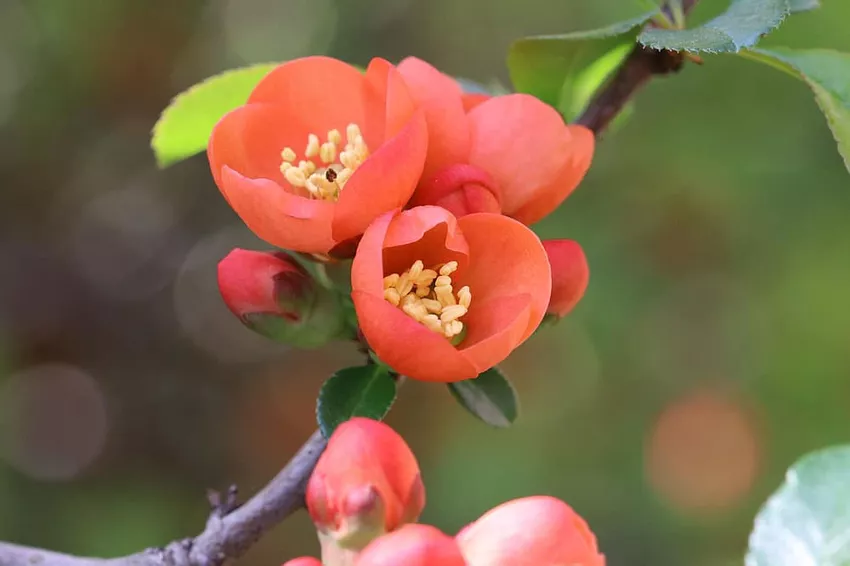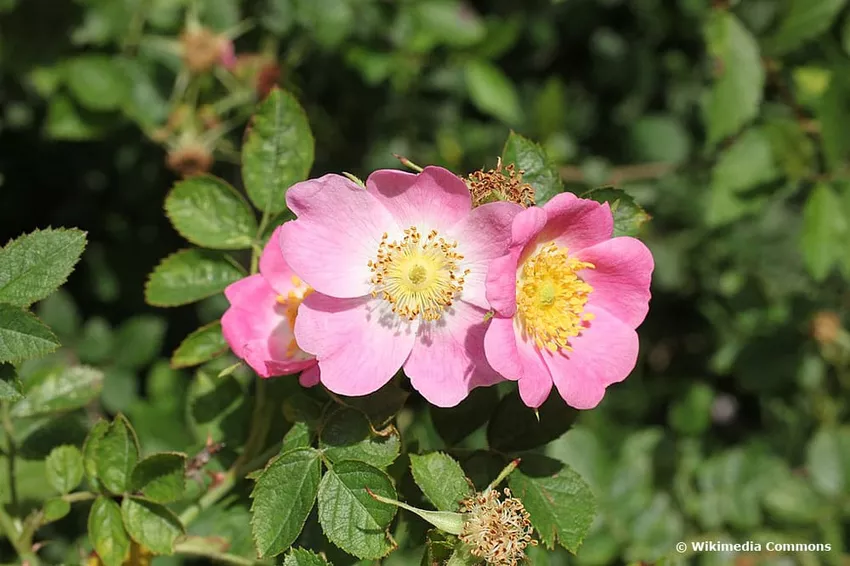
Shrubs with flowers enchant with their color, the scent and the visitors like bees and butterflies. Numerous species and varieties can present themselves in your garden and set appealing color accents.
In a nutshell
- The natural flower color does not always correspond to individual breeding variations, such as lilac varieties
- Flower colors can change from the basic color to other tones
- Overlapping flowering periods guarantee color throughout the year
- White flowers are the most common on shrubs
Sorted by color: 100 flowering shrubs
If you are looking for flowering shrubs, there are numerous plants in different colors available. The color of the flowers is crucial if you have a specific project in mind and want to make it decorative. The respective color can be created naturally or deliberately bred. So don't be surprised if the variety differs from the basic color, as there is a very large selection. In the next sections, you will be introduced to 100 shrubs in different shades along with their flowering times. This way you know immediately which color you can look forward to in a certain month. It is also advisable to select plants in such a way that the flowering times overlap. So you can enjoy splashes of color in your garden every season.
 Burnet rose, Source: Andrea Moro, Rosa spinosissima inflorescence (88), Edited by Plantopedia, CC BY-SA 3.0
Burnet rose, Source: Andrea Moro, Rosa spinosissima inflorescence (88), Edited by Plantopedia, CC BY-SA 3.0
Notes: Many hydrangea species (Hydrangea) can be influenced in their coloring by the pH value of the soil and are therefore an interesting alternative to the other flowering shrubs. For example, you get blue hydrangeas if the pH value is not 5 .5, while you can look forward to pink flowers from 6.0.
Classic flower color: 33 bushes in white
The most common flower color for trees is white. Numerous rose plants (Rosaceae) and many other families and genera form the clearly recognizable flowers. The following overview lists 33 of them:
- African Forest Gardenia (Gardenia thunbergia): Summer (depending on temperature)
- Apples (penalty): May
- Burnet rose (Rosa spinosissima): May to late June
- Blackberry (Rubus sect. Rubus): June to August
- Fragrant farmer's jasmine (Philadelphus coronarius): Beginning of May to June
- Rowan (Sorbus aucuparia): May
- Single hawthorn (Crataegus monogyna): May to June
- European holly (Ilex aquifolium): early May to early June
 Fragrant peasant jasmine (Philadelphus coronarius), European holly (Ilex aquifolium)
Fragrant peasant jasmine (Philadelphus coronarius), European holly (Ilex aquifolium)
- Field rose (Rosa arvensis): June to late July
- Firethorns (Pyracantha): May to June
- Garden privet (Ligustrum ovalifolium): June to mid-July
- Double star bush 'Plena' (Deutzia scabra 'Plena'): May to early June
- Serviceberry (Amelanchier ovalis): April
- Common privet (Ligustrum vulgare): June to July
- Honeysuckle (Lonicera xylosteum): Early May to June
 Firethorns (Pyracantha), Honeysuckle (Lonicera xylosteum)
Firethorns (Pyracantha), Honeysuckle (Lonicera xylosteum)
- Raspberry (Rubus idaeus): May to June
- Heavenly bamboo (Nandina domestica): June to late July
- Japanese Ysander (Pachysandra terminalis): February to May (varies)
- Cherry Plum (Prunus cerasifera): Late March to April
- Laurel cherry (Prunus laurocerasus): April to mid-May
- Medlar (Mespilus germanica): late May to early June
- Red photinia 'Red Robin' (Photinia fraseri 'Red Robin'): May to June
 Japanese Ysander (Pachysandra terminalis), Red medlar 'Red Robin' (Photinia fraseri 'Red Robin')
Japanese Ysander (Pachysandra terminalis), Red medlar 'Red Robin' (Photinia fraseri 'Red Robin')
- Red dogwood (Cornus sanguinea): May to June, early August (second flowering)
- Red elder (Sambucus racemosa): April to mid-May
- Siberian feather spar (Sorbaria sorbifolia): June to mid-August
- Blackthorn (Prunus spinosa): Beginning of March to April
- Viburnum Bladder (Physocarpus opulifolius): mid-May to mid-July
- Snowballs (Viburnum): April to mid-June or November to March (depending on species)
- Black elder (Sambucus nigra): mid-May to July
- Prickly-leaved osmanthus (Osmanthus heterophyllus): August to mid-October
- Star magnolia (Magnolia stellata): March to April
- Wild pear (Pyrus pyraster): April to mid-June
- Small-leaved lime (Tilia cordata): June to July
 Siberian pinnae (Sorbaria sorbifolia), star magnolia (Magnolia stellata)
Siberian pinnae (Sorbaria sorbifolia), star magnolia (Magnolia stellata)
Shrubs with pretty flowers: 12 species in yellow
While the number of yellow perennials and flowers is extremely high, the shrubs are somewhat reserved here. Nevertheless, you don't have to do without the cheerful dash of color in the garden or in the tub. Favorites like the witch hazel know how to inspire with their yellow tone.
- Chinese witch hazel (Hamamelis mollis): January to mid-March
- Fingerbush (Potentilla fruticosa): June to mid-October
- Forsythia (Forsythia intermedia): mid-March to mid-May (depending on the variety)
- Common barberry (Berberis vulgaris): May to late June
- Broom (Genista): April to mid-June
 Forsythia (Forsythia intermedia), stone broom (Genista lydia)
Forsythia (Forsythia intermedia), stone broom (Genista lydia)
- Japanese Kerrie (Kerria japonica): mid-April to July, August to late September (second flowering)
- Cornus (Cornus mas): March to April
- Smoke bush (Cotinus coggygria): May to June
- Sea Buckthorn (Hippophae rhamnoides): March to mid-May
- Small-leaved lime (Tilia platyphyllos): June
- Norway maple (Acer platanoides): April to mid-May
- Western Buttonbush (Cephalanthus occidentalis): Early July to August
 Japanese kerrie (Kerria japonica), Norway maple (Acer platanoides)
Japanese kerrie (Kerria japonica), Norway maple (Acer platanoides)
Rare: 5 orange flowering shrubs
Probably the rarest color and always a highlight after the planting season are orange flowering plants. Do not be surprised. The color is sometimes more yellow or red.
- Bell-shaped bell (Enkianthus campanulatus): May to June
- Japanese Azalea 'Satschiko' (Rhododendron obtusum 'Satschiko'): Late May to June
- Japanese quince (Chaenomeles japonica): March
- Pontic Azalea 'Orange Hit' (Rhododendron luteum 'Orange Hit'): Late May to early July
- Butterfly bush (Buddleja davidii): July to September
 Japanese quince (Chaenomeles japonica)
Japanese quince (Chaenomeles japonica)
8 shrubs with red flowers
Red blooms are always a unique sight when contrasted with the foliage. The following list contains 8 attractive flowering shrubs in red for you:
- Brazilian powder puff bush (Calliandra tweedii): almost all year round (depending heavily on temperature and location)
- Chinese rose mallow (Hibiscus rosa-sinensis): June to mid-October
- Vinegar rose (Rosa gallica): June to late July
- Dog rose (Rosa canina): June to late July
- Japanese weigela (Weigela japonica): April to mid-May
- Camellias (Camellia): September to April (depending on species)
- Strap blossom 'Black Pearl' (Loropetalum chinense 'Black Pearl'): April to mid-October
- Summer Spira 'Froebelii' (Spiraea japonica 'Froebelii'): July to late September
 Chinese rose mallow (Hibiscus rosa-sinensis), camellia (Camellia japonica)
Chinese rose mallow (Hibiscus rosa-sinensis), camellia (Camellia japonica)
Notice: The camellia is one of the shrubs that are also available in white or pink. However, the most famous are the picturesque flowers in red hues.
Flowers in pink or fuchsia: 15 presented
Shrubs that shine in pink or pink are just as appealing as the white flowering shrubs. Among the most beautiful are those of the Japanese ornamental cherries, when they catch the eye during the cherry blossom season.
- Mountain laurel (Kalmia latifolia): April to mid-June
- Damask roses (Rosa damascena): June
- Spring tamarisk (Tamarix parviflora): end of May to June
- Pike rose (Rosa glauca): June to late July
- Japanese Blossom Skimmia 'Rubella' (Skimmia japonica 'Rubella'): April to May
- Japanese lavender heather (Pieris japonica): March to mid-May
- Potato rose (Rosa rugosa): June to late September
 Mountain laurel (Kalmia latifolia), potato rose (Rosa rugosa)
Mountain laurel (Kalmia latifolia), potato rose (Rosa rugosa)
- Kolkwitzia (Kolkwitzia amabilis): May to June
- Lagerströmie (Lagerstroemia): August to mid-October
- Almond bush (Prunus triloba): March to May
 Kolkwitzia (Kolkwitzia amabilis), almond bush (Prunus triloba)
Kolkwitzia (Kolkwitzia amabilis), almond bush (Prunus triloba)
- East Asian Cherry 'Kanzan' (Prunus serrulata 'Kanzan'): Early May to 3rd week of May
- Pink Myrtle Heather (Melaleuca acuminata): Summer (depending on temperature)
- Gaultheria: mid-July to mid-August
- Peat myrtle (Gaultheria mucronata): May to June
- Wine Rose (Rosa rubiginosa): June to early July
 Vine rose (Rosa rubiginosa), Source: FreeUsePhotos, Rosa rubiginosa inflorescence (24), Edited from Plantopedia, CC0 1.0
Vine rose (Rosa rubiginosa), Source: FreeUsePhotos, Rosa rubiginosa inflorescence (24), Edited from Plantopedia, CC0 1.0
8 "blue-flowered" shrubs
Blue flowers on shrubs fascinate with their many gradations, ranging from light to dark. If you're obsessed with color, check out the following plants:
- Australian mint (Prostanthera rotundifolia): early April to May
- Bearded Beard (Caryopteris): Early August to September
- Broad-leaved chaste tree (Vitex agnus-castus latifolia): September to October
- False Indigo (Amorpha fruticosa): April to mid-August
- Cape Plumbago (Plumbago auriculata): March to December (depending on location)
- Ceanothus: mid-August to late October
- Pigeonberry 'Geisha Girl' (Duranta erecta 'Geisha Girl'): Summer (depending on temperature)
- Vanilla Flower (Heliotropium arborescens): Late June to mid-October
 Cape leadwort (Plumbago auriculata), buckskin (Ceanothus)
Cape leadwort (Plumbago auriculata), buckskin (Ceanothus)
9 shrubs with violet flowers
Purple flowers are just as popular as blue ones. Depending on the project, these can be a real eye-catcher.
- Bristly black locust (Robinia hispida): May to June
- Chinese beauty fruit (Callicarpa giraldii): June to July
- True lavender (Lavandula angustifolia): June to late August
- Common wolfberry (Lycium barbarum): June to August
- Mezereon (Daphne mezereum): March to April
- Bald bougainvillea (Bougainvillea glabra): mid-August to late November
- Small-leaved rhododendron (Rhododendron impeditum): May
- Cretan Rockrose (Cistus creticus): December to April
- Shrub veronica 'Addenda' (Hebe 'Addenda'): August to October
 Common Lavender (Lavandula angustifolia), Bald Triplet (Bougainvillea glabra)
Common Lavender (Lavandula angustifolia), Bald Triplet (Bougainvillea glabra)
10 green flowering shrubs
Last but not least, we must not forget the flowering shrubs, whose flowers are greenish. Although these are often not as conspicuous as those of the other species, they have their own special charm. Many of the flowers mix green with white or yellow, rarely red.
- Ivy 'Arborescens' (Hedera helix 'Arborescens'): Late August to October
- Buckthorn (Rhamnus frangula): late May to September
- Gray willow (Salix eleagnos): March to April
- Common boxwood (Buxus sempervirens): March to May (only from the age of ten)
- Spindle (Euonymus europaeus): May to mid-June
- Deer butt sumac (Rhus typhina): from June
- Japanese Aukube 'Rozannie' (Aucuba japonica 'Rozannie'): May to June
- Purging buckthorn (Rhamnus cathartica): May to June
- Red currant (Ribes rubrum): April to May
- Gooseberry (Ribes uva-crispa): April to May
 Red currant (Ribes rubrum)
Red currant (Ribes rubrum)
frequently asked Questions
When is the typical planting time for flowering shrubs?The right planting time, not just the location, of shrubs is important if you choose one or more of the varieties or species mentioned. Bare root shrubs, especially roses, are ideally planted on frost-free days from October to November, at the latest by the beginning of March. The planting time for shrubs with soil balls can still be up to the end of May, for pot balls up to the end of June. Cold-sensitive plants are only planted from the end of March to the end of April.
When to prune shrubs for lush floweringMany of the plants mentioned not only need a suitable location or the right care. In order to stimulate flowering, the shrubs are pruned either in early spring or after their spring flowering, depending on the flowering period. Summer or fall bloomers encourage budding from January to April by pruning, while spring bloomers like lilacs are pruned after flowering to strengthen them. You can even do this cut in the fall.
What are the advantages of planting native flowering shrubs?Native plants provide a source of food and shelter for numerous animals such as bees, butterflies, beetles, spiders, birds, hedgehogs and even lizards. The attractive and fragrant flowers are visited by insects, while the dense branches protect against the weather or predators. In cities in particular, the trees and shrubs are important for the preservation of numerous species that have been displaced due to urbanization.